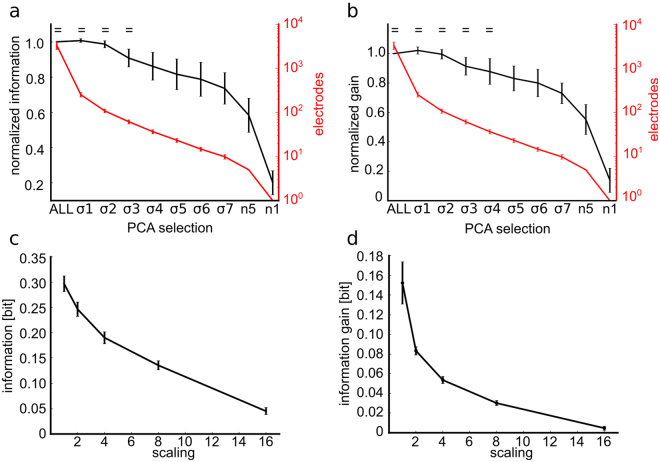Figure 7.
The information and information gain are carried by a subset of electrodes. For each experiment and PC, we selected subgroups of electrodes with PC weight (i.e. eigenvector values) higher than 1 to 7 standard deviations (σ1 to σ7) from the mean PC. We also selected electrodes with the highest (n1) and highest five (n5) PC weights. For any selection, the information and the information gain are averaged across PCs and experiments (n = 4) and the corresponding means and SEM are reported. (a) The mean information of the selected electrodes is comparable to the information of the entire electrode array (ALL) up to σ3, that corresponds to ~61 selected electrodes (F(9, 390) = 26.4, p = 10−35). The symbol = marks the data group that has similar means (Tukey’s HSD, p < 0.05), see Supplementary Information. (b) The mean information gain of the selected electrodes is comparable to the entire set of electrodes (ALL) up to σ4, that corresponds to ~37 electrodes (F(9, 390) = 20.9, p = 10−29). Stars indicate no significantly different means respect to ALL (one-way between subject ANOVA followed by Tukey’s HSD multiple comparison test). The symbol = marks the data group that has similar means (Tukey’s HSD, p < 0.05), see Supplementary Information. (c) The information decreases steeply with the downscaling of the number of recording electrodes (i.e. the scaling factors 2, 4, 8 and 16 correspond to down-sampled arrays of size 32 × 32, 16 × 16, 8 × 8 and 4 × 4, respectively). (d) The information gain decreases even more steeply and decays almost to half of its value with a downscaling of 2. For each scaling factor the information and the information gain are computed for different samplings of the available 64 × 64 electrodes. The mean and SEM over the different samplings are reported.

